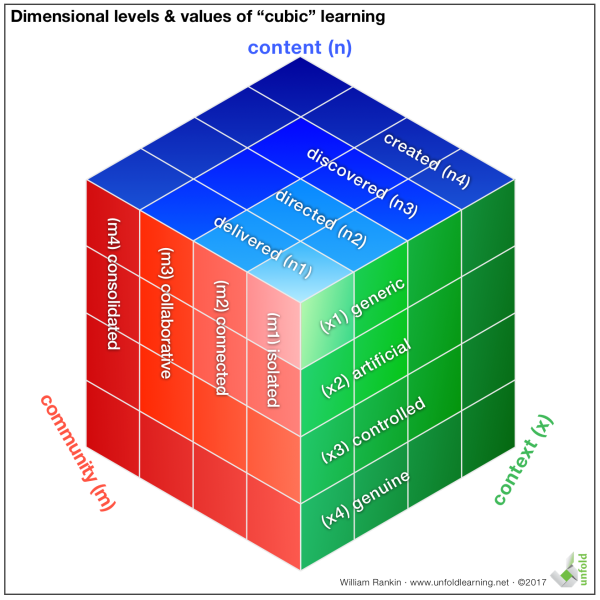This post is the third in a series using “engagement and learning multiplier” (ELM) assessments to examine some common teaching and learning methods. If you’d like to (re)familiarize yourself with how these assessments work, you can refer to this post. If you’d like to compare this current post’s ELM assessment with others I’ve done, you can find the assessment of a laboratory course here, and you can find the rest of the “cubic” assessments in the sidebar (which may be at the bottom of this screen if you’re reading this on a mobile device).
For each of these assessments, I’ll set the learning scenario and then present analysis about why that approach has a given “cubic” shape and why it receives a particular ELM score. These posts are designed to provide useful examples and guidance as you evaluate your own learning approaches and as you make your own teaching and technology choices.
A problem-based learning course
Description
This middle-school social studies course is organized around a single major concept: building a human colony on Mars. Learners work through three separate phases of this concept over the course of the year: 1) the initial planning and colonization — deciding what would be needed to establish a colony and who should be invited as initial settlers; 2) the running of the colony — deciding what system of laws and government should characterize the settled colony; and 3) the expansion of the colony — deciding how to attract new settlers from earth to come and expand the colony’s capabilities. While the teacher has determined this overall structure, the details of what learners plan, what they make to demonstrate their plan (to both peers and parents), and how they present their work are all entirely left up to the learners. The teacher begins the course by introducing learners to Scrum, the collaboration method originally developed to help software developers work more productively together (see this helpful post by Bea Leiderman about Scrum in school). All work in the course is developed by learners using this method, with the teacher serving as the “Product Owner.”
Learners form their own teams of three to five members whom they choose based on a “skills résumé” (accompanied by examples where appropriate) that each learner prepares and presents to the class: descriptions of drawing or artistic ability, experience making movies, writing or math skills, knowledge of particular software or apps, etc. These teams will stay together throughout the year — though learners are also encouraged to “cross-pollinate” by seeking help from other teams if they need something no one on their own team can provide. Cross-pollination works by means of barter: teams have to negotiate, with one team offering services the other team wants in exchange for the services the first one needs. Any team that finishes a project before the other teams is signified a “consulting group”: its members are expected to split up and serve the other groups by helping with whatever they need. If a team experiences any interpersonal difficulties, its members are responsible for working those difficulties out themselves (though the teacher offers guidance and resources if the team members request help). The role of Scrum Master rotates through all of the team’s members during the first unit, with every member serving as Scrum Master at least once. After that, team members are allowed to choose their own roles based on their abilities and their team’s collective sense of how they can serve best.
Every class day begins with a “Stand-Up,” during which learners show the products of their work to one another, deal with delays or impediments, and decide what their work for the day will involve. Following this initial meeting, the teacher might briefly present relevant materials, involve students in a mini-project, or ask one of the teams to present some of their recent discoveries or work. She also provides materials on the class blog with the understanding that learners will use these as a starting point for their own explorations and creations. As learners develop their projects, they conduct research, develop media, and share results, all facilitated by the tablet devices the school provides for each learner. Teams present the results of the first two project phases in December and March during evening assemblies open to the public. Each team posts its assembled materials on the course blog for “public review” one week prior to the assembly, and is expected to use feedback gathered from this review period and from the public forum to revise their work. Each group gives a 10-minute presentation followed by 10 minutes of public Q&A. At the end of each forum, the assembled audience votes on which group presented the most compelling plan, which produced the best presentation, and which demonstrated the best responses to the audience’s questions. Many former class members participate in these public reviews “just for fun,” though the top team from the previous year serves as a formal “review committee” — service they perform both for the honor of the position and for the pizza party they get during final reviews. The “review committee” provides specific observations about what each group has done well and what each group needs to improve. In late May, learners present the results of the final project phase to the entire school, and the assembled school votes on which settlement they’d most like to join — and why. These three public forums (and the materials prepared for them) take the place of course exams.
The top team (and next year’s “review committee”) is chosen by combining the results of the three public forums and an end-of-year, in-class vote determining which overall project was the best researched, best supported, and best presented — a process which the previous year’s “review committee” referees.




You must be logged in to post a comment.